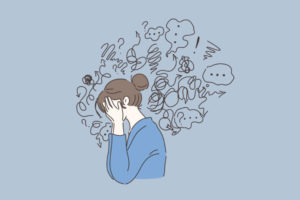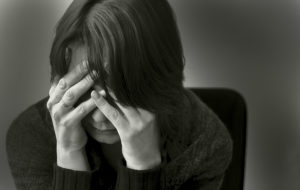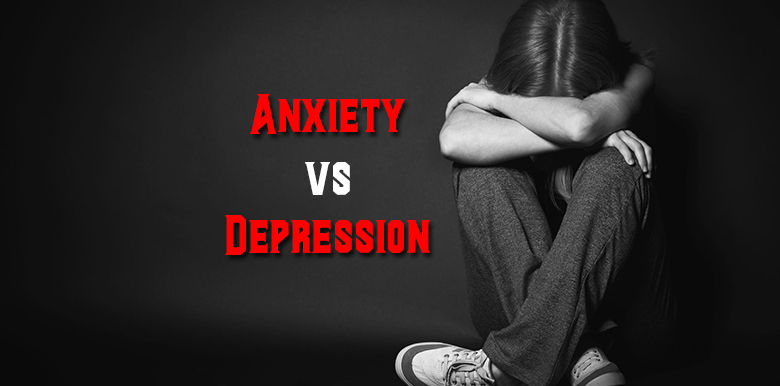What is Anxiety?
Anxiety is a worry about future events, and fear is a reaction to recent events. These feelings may cause physical symptoms, such as a fast heart rate and shakiness.

Anxiety
Types of Disorders –
Anxiety disorder is an umbrella term that includes different conditions:
Panic disorder – You feel terror that strikes at random. During a panic attack, you may also sweat, have chest pain, and feel palpitations (unusually strong or irregular heartbeats). Sometimes you may feel like you’re choking or having a heart attack.
Social anxiety disorder – Also called social phobia, this is when you feel overwhelming worry and self-consciousness about everyday social situations. You fixate about others judging you or on being embarrassed or ridiculed.
Specific phobias – You feel intense fear of a specific object or situation, such as heights or flying. The fear goes beyond what’s appropriate and may cause you to avoid ordinary situations.
Causes
Researchers don’t know exactly what brings on anxiety disorders. Like other forms of mental illness, they stem from a combination of things, including changes in your brain and environmental stress, and even your genes. The disorders can run in families and could be linked to faulty circuits in the brain that control fear and other emotions.
What is Depression?
Depression is a common and serious medical illness that negatively affects how you feel, the way you think and how you act.

Depression
Types of Depression –
Major Depression
You may hear your doctor call this “major depressive disorder.” You might have this type if you feel depressed most of the time for most days of the week.
Some other symptoms you might have are:
-Loss of interest or pleasure in your activities
-Weight loss or gain
-Trouble getting to sleep or feeling sleepy during the day
-Feelings restless and agitated, or else very sluggish and slowed down physically or mentally
-Being tired and without energy
-Feeling worthless or guilty
-Trouble concentrating or making decisions
-Thoughts of suicide
Persistent Depressive Disorder
If you have depression that lasts for 2 years or longer, it’s called persistent depressive disorder. This term is used to describe two conditions previously known as dysthymia (low-grade persistent depression) and chronic major depression.
It’s normal to feel down once in a while, but if you’re sad most of the time and it affects your daily life, you may have clinical depression. It’s a condition you can treat with medicine, talking to a therapist, and changes to your lifestyle.
There are many different types of depression. Events in your life cause some, and chemical changes in your brain cause others.
Whatever the cause, your first step is to let your doctor know how you’re feeling. She may refer you to a mental health specialist to help figure out the type of depression you have. This diagnosis is important in deciding the right treatment for you.
Major Depression
You may hear your doctor call this “major depressive disorder.” You might have this type if you feel depressed most of the time for most days of the week.
Some other symptoms you might have are:
-Loss of interest or pleasure in your activities
-Weight loss or gain
-Trouble getting to sleep or feeling sleepy during the day
-Feelings restless and agitated, or else very sluggish and slowed down physically or mentally
-Being tired and without energy
-Feeling worthless or guilty
-Trouble concentrating or making decisions
-Thoughts of suicide
Persistent Depressive Disorder
If you have depression that lasts for 2 years or longer, it’s called persistent depressive disorder. This term is used to describe two conditions previously known as dysthymia (low-grade persistent depression) and chronic major depression.
You may have symptoms such as:
-Change in your appetite (not eating enough or overeating)
-Sleep too much or too little
-Lack of energy, or fatigue
-Low self-esteem
-Trouble concentrating or making decisions
-Feel hopeless
-You may be treated with psychotherapy, medication, or a combination of the two.
Bipolar Disorder
Someone with bipolar disorder, which is also sometimes called “manic depression,” has mood episodes that range from extremes of high energy with an “up” mood to low “depressive” periods.
When you’re in the low phase, you’ll have the symptoms of major depression.
Seasonal Affective Disorder (SAD)
Seasonal affective disorder is a period of major depression that most often happens during the winter months, when the days grow short and you get less and less sunlight. It typically goes away in the spring and summer.
Psychotic Depression
People with psychotic depression have the symptoms of major depression along with “psychotic” symptoms, such as:
-Hallucinations (seeing or hearing things that aren’t there)
-Delusions (false beliefs)
-Paranoia (wrongly believing that others are trying to harm you)
-A combination of antidepressant and antipsychotic drugs can treat psychotic depression. ECT may also be an option.
Peripartum (Postpartum) Depression
Women who have major depression in the weeks and months after childbirth may have peripartum depression. Antidepressant drugs can help similarly to treating major depression that is unrelated to childbirth.
Premenstrual Dysphoric Disorder (PMDD)
Women with PMDD have depression and other symptoms at the start of their period.
Besides feeling depressed, you may also have:
-Mood swings
-Irritability
-Anxiety
-Trouble concentrating
-Fatigue
-Change in appetite or sleep habits
-Feelings of being overwhelmed
-Antidepressant medication or sometimes oral contraceptives can treat PMDD.
Situational’ Depression
This isn’t a technical term in psychiatry. But you can have a depressed mood when you’re having trouble managing a stressful event in your life, such as a death in your family, a divorce, or losing your job. Your doctor may call this “stress response syndrome.”
Psychotherapy can often help you get through a period of depression that’s related to a stressful situation.
Atypical Depression
This type is different than the persistent sadness of typical depression. It is considered to be a “specifier” that describes a pattern of depressive symptoms. If you have atypical depression, a positive event can temporarily improve your mood.
Other symptoms of atypical depression include:
-Increased appetite
-Sleeping more than usual
-Feeling of heaviness in your arms and legs
-Oversensitive to criticism
Cause –
Depression is an extremely complex disease. No one knows exactly what causes it, but it can occur for a variety of reasons. Some people experience depression during a serious medical illness. Others may have depression with life changes such as a move or the death of a loved one. Still others have a family history of depression.
How is Anxiety and Depression different?
The physical state of anxiety can be conceptualized overall as that of heightened arousal. Specific characteristics include:
-Muscle tension
-Gastrointestinal distress (for example, nausea, diarrhea, or constipation)
-Dizziness
-Increased heart rate, blood pressure, sweating
-Shortness of breath
-Difficulty falling or staying asleep due to racing thoughts or other physical symptoms
-Difficulty concentrating due to state of agitation or racing thoughts
Depression is primarily characterized by changes in usual physical processes from baseline, such as:
-Loss of appetite or a significant increase in appetite
-Lack of energy
-Physical achiness without cause
-Moving or talking more slowly than usual
-Sleeping much more or much less than is typical due to ruminative thought processes or low energy
-Difficulty with concentration, focus, and memory due to ruminative thought processes or other physical symptoms
Ultimately, the physical symptoms of either anxiety or depression can be exhausting for the afflicted individual.
